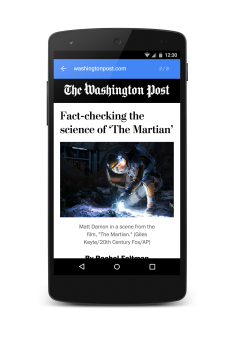Google launches Accelerated Mobile Pages in move to drive faster content
Google has joined Facebook and Apple’s race to speed up the mobile web with the launch of a new project aimed at helping publishers accelerate load times.

The Accelerated Mobile Pages Project, announced overnight, will allow publishers to cache content on Google’s servers, which means users around the world should see pages upload to their device almost instantly.
 The project also aims to support subscriptions and paywalls. So far 26 publishers, covering 42 publications, have signed up to integrate AMP , including the Washington Post and the Guardian.
The project also aims to support subscriptions and paywalls. So far 26 publishers, covering 42 publications, have signed up to integrate AMP , including the Washington Post and the Guardian.
AMP allows publishers to build light-weight versions of pages that load instantaneously on mobile with 26 publishers around the world already signed on, including Fairfax Media, The Washington Post , The Guardian and Ninemsn.
Richard Gingras, head of news at Google, told Mumbrella: “The AMP project is an open-source initiative to make it incredibly simple for publishers to make mobile-friendly pages to make the web what we would like it to be.
AMP is a set of HTML code that publishers are able to use to build light-weight web pages for their content whilst retaining control its look and feel.
Google’s VP of engineering, Search David Besbris explained: “It knows how to do all the great modern stuff that you need on webpages like slideshows and it does it very, very well. It does not mean the code is enforcing a template on the publishers.”

Savva: Fast pages and wider distribution
Fairfax Media’s mobile product director Stefan Savva told Mumbrella: “What it really means is two really important things. The first is about fast pages. That’s come about because of this contradiction that you hear readers saying I want everything, I want a great experience, I want all the content that you see on desktop but I don’t want to suffer because I’m a mobile handset so I want my content to be really super quick.”
Savva said the product is also about wide distribution.
“Certainly what you’ll see is Sydney Morning Herald and AFR content appear at the top of Google search results. But that’s only part of the picture,” he said.
“What you’ll also see is that same content distributed on Google search results, on Google Now, in Google news stands and in a wide variety of parties that Google are working with.”
While Facebook’s Instant Articles also looks to solve the problem of slow loading speeds on mobile devices, Google rejected any suggestions AMP was intended to compete with Facebook’s Instant Articles.
He said: “The primary motivation is, as it always is at Google, to make the user experience great,” he said.
“These pages will work anywhere you have a web browser and these pages will work inside Twitter and on Facebook.”
Ninemsn editor-in-chief and publisher Hal Crawford said: “The competition in this sphere is really heating up, you’ve got Apple News format, Instant Articles, Google AMP. All these formats are competing with each other to some extent but they are also differentiated and each one has a different take on it, which is great for publishers.
“I’m happy because each one has things to recommend it. We are definitely open to all of these platforms.”
Miranda Ward




 Linkedin
Linkedin
The Goog is concerned that the ad blockers will force content to go behind the paywall.
Not only will the Goog lose ad revenue, they will also lose content and their results/answers will become stale and they won’t be able to “collect” it and then serve it themselves….
What better way to get around this than have all the content (and ads) actually served by Goog themsleves.
User ID not verified.
@ Thomas. If the result is a far quicker page load, so I can access content immediately. Plus the advertiser actually has their advert seen; then win win!
User ID not verified.